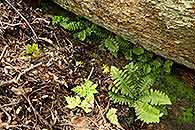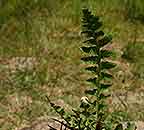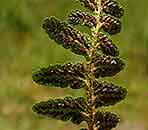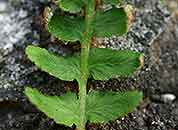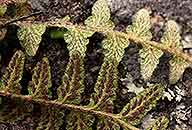Asplenium phillipsianum (Kümmerie) Bir, Fraser-Jenk. & Lovis
Synonyms |
Ceterach phillipsianum Kümmerle |
|---|---|
Common name |
|
Description |
Rhizome erect or procumbent, c.4 mm in diameter, scales dark-chestnut coloured, lanceolate, margin paler sometimes toothed, up to 4 mm long. Fronds sometimes proliferous in the sinuses of the apical lobes, tufted, suberect to spreading. Stipe very short, 5-30 mm long, dark chestnut brown; scales shiny, brown, up to 4 mm long. Lamina 5-13 × 1.5-5 cm, pinnatisect to shallowly 2-pinnatifid, elliptic to obovate in outline, herbaceous, inrolled when dry; basal pinnae gradually decrescent. Pinnae attached to the rhachis throughout, base prolonged down the rhachis, narrowly ovate-oblong, margins entire to weakly sinuate, apex rounded, undersurface very sparsely covered with scales; scales brown, lanceolate, c. 2.5 mm long. Rhachis somewhat winged apically, not winged between widely spaced pinnae basally; scales like stipe scales, 4 mm long. Sori linear, 2-3 mm long becoming confluent at maturity, not totally obscured by scales, exindusiate. |
Notes | Untill recently this species was included within the broad concept for A. cordatum.
|
Derivation | phillipsianum: type specimen was collected by the English explorer E. Lort-Phillips (1857-1944). |
Habitat | Close to streams and under trees on steep, damp earth banks. |
Distribution worldwide | South Africa, extending to central and tropical East Africa, Madagascar. |
Distribution in Africa |
|
Growth form |
Lithophytic. |
Literature |
|
